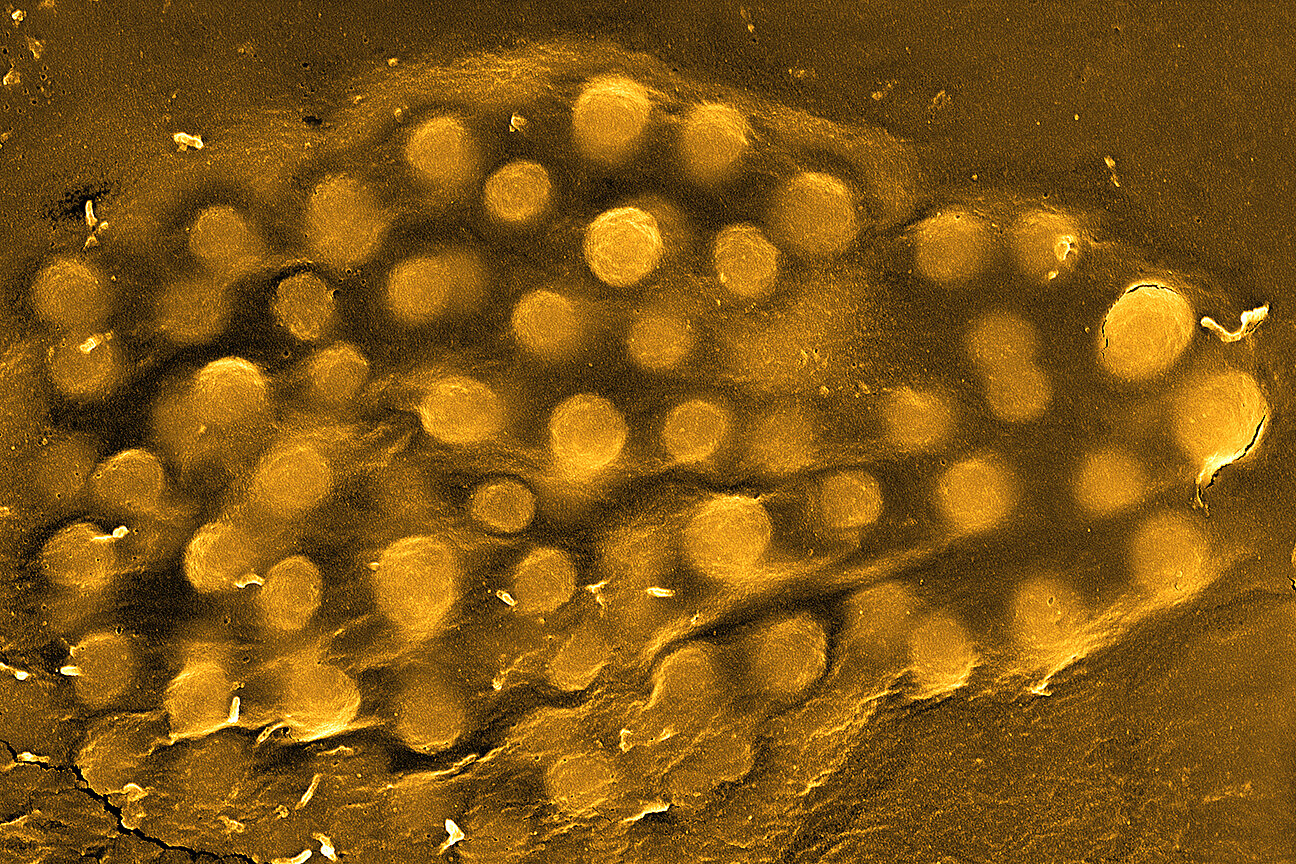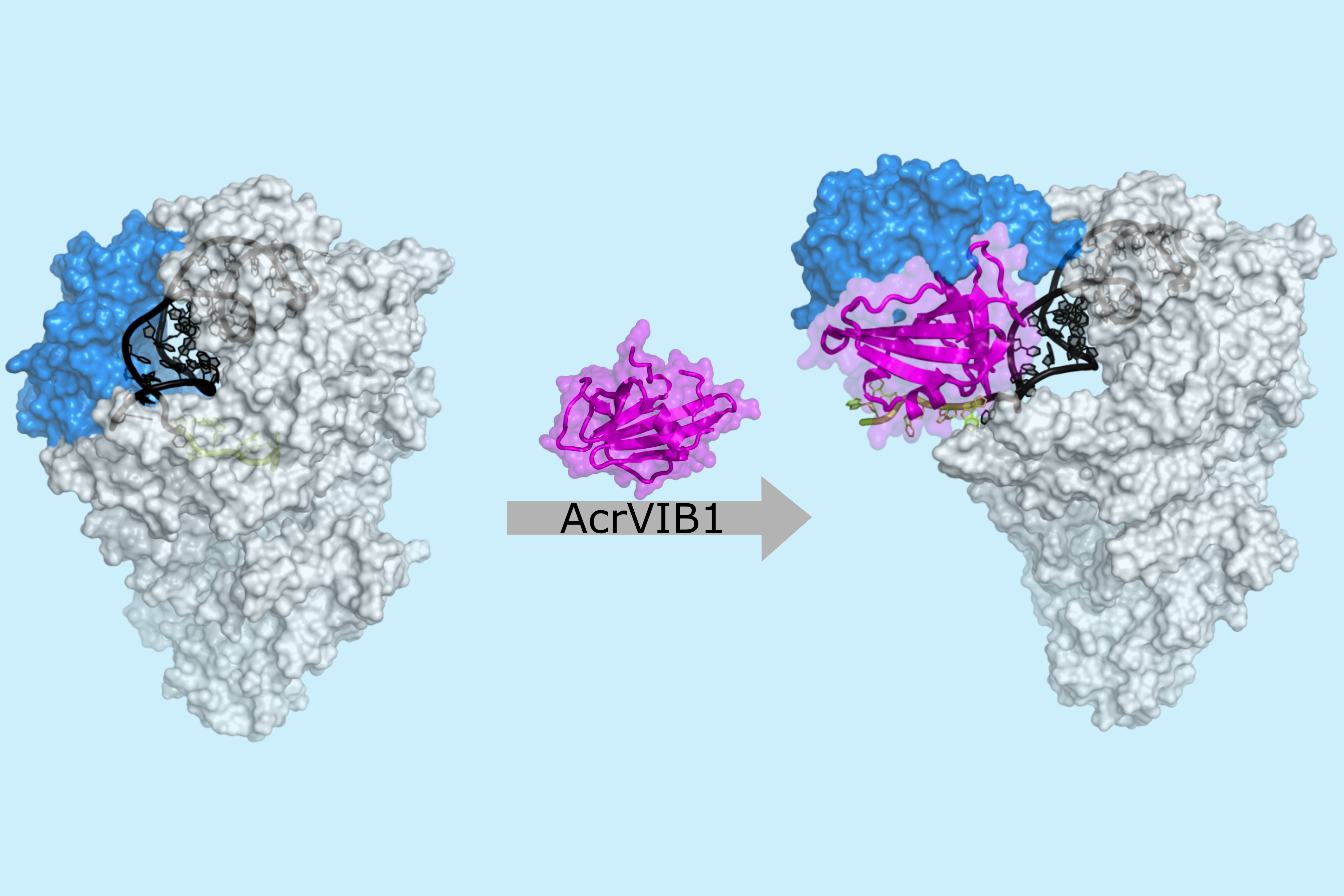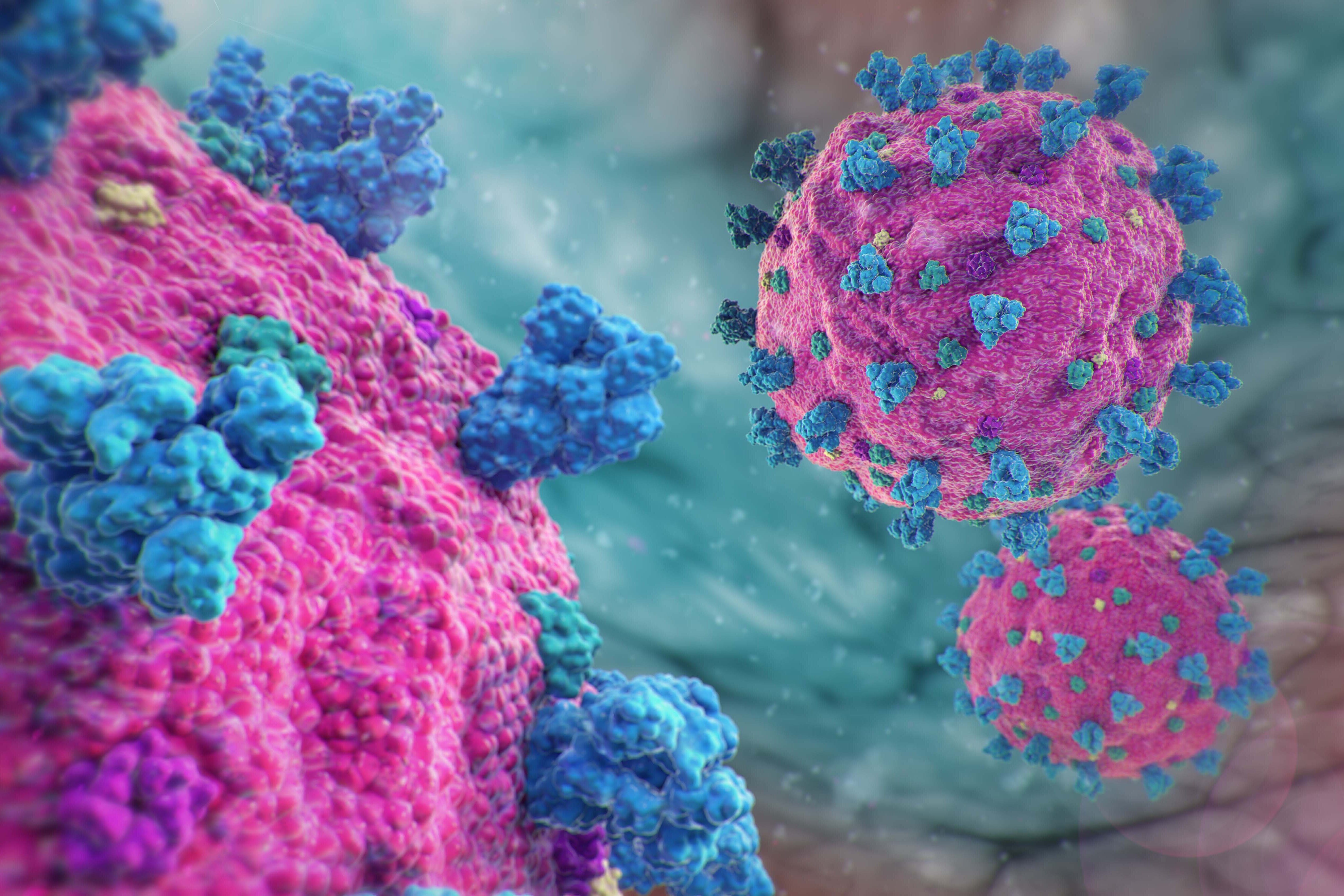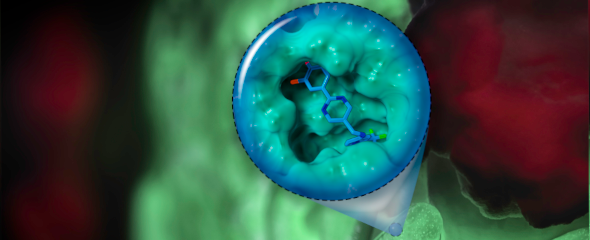Author count: 16
Thiemann M., Zimmermann M., Diederich C., Zhan H., Lebedev M., Pletz J., Baumgarten J., Handke M., Müsken M., Breinbauer R., Krasteva-Christ G., Zanin E., Empting M., Schiedel M., ... , Kunick C., Blankenfeldt W.
(2025)
From Bones to Bugs: Structure-Based Development of Raloxifene-Derived Pathoblockers That Inhibit Pyocyanin Production in Pseudomonas aeruginosa
J.Med.Chem.
Author count: 14
Schmidt K., Charria-Giron E., Gorelik T.E., Kleeberg C., Muema J.M., Heitkämper S., Verwaaijen B., Kuhnert E., Gerke J., Kalinowski J., Hyde K.D., Stadler M., ... , Cox R., Surup F.
(2025)
Lienhwalides: Unique Tropolone-Maleidride Hybrids from Hypoxylon lienhwacheense
Chembiochem.
Author count: 1
Blankenfeldt W.
(2025)
Ice-forming bacteria
Biospektrum,
31
(1)
Author count: 4
Gorelik T.E., Miehe G., Bücker R., Yoshida K.
(2025)
Unit-cell parameters determination from a set of independent electron diffraction zonal patterns
Acta crystallogr., A Found.Adv.,
81
(Pt 2)
Author count: 9
Wandera K.G., Schmelz S., Migur A., Kibe A., Lukat P., Achmedov T., Caliskan N., ... , Blankenfeldt W., Beisel C.L.
(2025)
AcrVIB1 inhibits CRISPR-Cas13b immunity by promoting unproductive crRNA binding accessible to RNase attack
Mol.Cell,
85
(6)
Author count: 5
Zhao M., Chen C., Blankenfeldt W., Pessler F., Büssow K.
(2025)
Effect of pH and buffer on substrate binding and catalysis by cis-aconitate decarboxylase
Scientific Reports,
15
(1)
Author count: 16
Bdeir N., Lüddecke T., Maaß H., Schmelz S., Rand U., Jacobsen H., Metzdorf K., Kulkarni U., Cossmann A., Stankov M.V., Hoffmann M., Pöhlmann S., Blankenfeldt W., Dopfer-Jablonka A., ... , Behrens G.M.N., Cicin-Sain L.
(2025)
Reverse mutational scanning of SARS-CoV-2 spike BA.2.86 identifies epitopes contributing to immune escape from polyclonal sera
Nat Commun,
16
(1)
Author count: 13
Lehky M., Moonian T., Michel T., Junker D., Müsken M., Strömpl J., Nübling P., Neumann F., Krumbholz A., Krause G., Schneiderhan-Marra N., ... , van den Heuvel J., Strengert M.
(2025)
A novel method for recombinant mammalian-expressed S-HBsAg virus-like particle production for assembly status analysis and improved anti-HBs serology
Protein Sci.,
34
(1)
Author count: 2
Waaga-Gasser A.M., Bödicke T.
(2024)
Genetically Engineered T Cells and Recombinant Antibodies to Target Intracellular Neoantigens: Current Status and Future Directions
Int.J.Mol.Sci.,
25
(24)
Author count: 33
Fenwick M.K., Pierce P.G., Abendroth J., Barrett K.F., Barrett L.K., Bowatte K., Choi R., Chun I., Conrady D.G., Craig J.K., Dranow D.M., Hammerson B., Higgins T., Lorimer D.D., Lukat P., Mayclin S.J., Hewitt S.N., Peng Y.P., Shanbhogue A., Smutney H., Stigliano M.Z.Z., Tillery L.M., Udell H.S., Wallace E.G., DeRocher A.E., Phan I.Q., Staker B.L., Subramanian S., Van Voorhis W.C., Blankenfeldt W., Müller R., ... , Edwards T.E., Myler P.J.
(2024)
Exquisite selectivity of griselimycin extends to beta subunit of DNA polymerases from Gram-negative bacterial pathogens
Commun.Biolog.,
7
(1)
Author count: 11
Kaspar F., Eilert L., Staar S., Oung S.W., Wolter M., Ganskow C.S.G., Kemper S., Klahn P., Jacob C.R., ... , Blankenfeldt W., Schallmey A.
(2024)
Biocatalytic Ether Lipid Synthesis by an Archaeal Glycerolprenylase
Angew.Chem.Int.Ed.
Author count: 11
Braun-Cornejo M., Ornago C., Sonawane V., Haupenthal J., Kany A.M., Diamanti E., Jezequel G., Reiling N., Blankenfeldt W., ... , Maas P., Hirsch A.K.H.
(2024)
Target-Directed Dynamic Combinatorial Chemistry Affords Binders of Mycobacterium tuberculosis IspE
ACS Omega,
9
(36)
Author count: 8
Charria-Giron E., Zeng H., Gorelik T.E., Pahl A., Truong K.N., Schrey H., ... , Surup F., Marin-Felix Y.
(2024)
Arcopilins: A New Family of Staphylococcus aureus Biofilm Disruptors from the Soil Fungus Arcopilus navicularis
J.Med.Chem.,
67
(17)
Author count: 7
Baumgarten J., Schneider P., Thiemann M., Zimmermann M., Diederich C., ... , Blankenfeldt W., Kunick C.
(2024)
Substrate-Based Ligand Design for Phenazine Biosynthesis Enzyme PhzF
ChemMedChem.
Author count: 7
Piskol F., Lukat P., Kaufhold L., Heger A., Blankenfeldt W., ... , Jahn D., Moser J.
(2024)
Biochemical and structural elucidation of the L-carnitine degradation pathway of the human pathogen Acinetobacter baumannii
Frontiers in Microbiology,
15
Author count: 9
Siddique M.N.A.A., Kellermeier F., Ölke M., Zhao M., Büssow K., Oefner P.J., Lührmann A., ... , Dettmer K., Lang R.
(2024)
Divergent effects of itaconate isomers on Coxiella burnetii growth in macrophages and in axenic culture
Frontiers in Immunology,
15
Author count: 10
Abdelsamie A.S., Hamed M.M., Schütz C., Röhrig T., Kany A.M., Schmelz S., Blankenfeldt W., Hirsch A.K.H., ... , Hartmann R.W., Empting M.
(2024)
Discovery and optimization of thiazole-based quorum sensing inhibitors as potent blockers of Pseudomonas aeruginosa pathogenicity
European Journal of Medicinal Chemistry,
276
Author count: 8
Behlendorf C., Diwo M., Neumann-Schaal M., Fuchs M., Körner D., Jänsch L., ... , Faber F., Blankenfeldt W.
(2024)
Formation of the pyruvoyl-dependent proline reductase Prd from Clostridioides difficile requires the maturation enzyme PrdH
PNAS Nexus,
3
(7)
Author count: 6
Truthe S., Klassert T.E., Schmelz S., Jonigk D., Blankenfeldt W., Slevogt H.
(2024)
Role of Lectin-Like Oxidized Low-Density Lipoprotein Receptor-1 in Inflammation and Pathogen-Associated Interactions
Journal of Innate Immunity,
16
(1)
Author count: 13
Mingers T., Barthels S., Mass V., Acuna J.M.B., Biedendieck R., Cooke A., Dailey T.A., Gerdes S., Blankenfeldt W., Dailey H.A., Warren M.J., ... , Jahn M., Jahn D.
(2024)
The alternative coproporphyrinogen III oxidase (CgoN) catalyzes the oxygen-independent conversion of coproporphyrinogen III into coproporphyrin III
Front.Microbiol.,
15
Author count: 5
Ajay A.K., Gasser M., Hsiao L.L., Böldicke T., Waaga-Gasser A.M.
(2024)
TLR2 and TLR9 Blockade Using Specific Intrabodies Inhibits Inflammation-Mediated Pancreatic Cancer Cell Growth
Antibodies (Basel),
13
(1)
Author count: 7
Storm A., Köster J., Ghorbani-Asl M., Kretschmer S., Gorelik T.E., ... , Krasheninnikov A.V., Kaiser U.
(2023)
Structural Transformations in Few-Layer MnPSe3 Stimulated by Thermal Annealing and Electron Irradiation
Journal of Physical Chemistry C,
127
(51)
Author count: 7
Hiller M., Diwo M., Wamp S., Gutsmann T., Lang C., ... , Blankenfeldt W., Flieger A.
(2023)
Structure-function relationships underpin disulfide loop cleavage-dependent activation of Legionella pneumophila lysophospholipase A PlaA
Mol.Microbiol.
Author count: 5
Gorelik T.E., Lukat P., Kleeberg C., Blankenfeldt W., Mueller R.
(2023)
Molecular replacement for small-molecule crystal structure determination from X-ray and electron diffraction data with reduced resolution
Acta Crystallogr.A Found.Adv.,
79
(6)
Author count: 5
Gorelik T.E., Beko S.L., Teteruk J., Heyse W., Schmidt M.U.
(2023)
Analysis of diffuse scattering in electron diffraction data for the crystal structure determination of Pigment Orange 13, C32H24Cl2N8O2
Acta Crystallogr.Sect.B Struct.Sci.Crys.Eng.Mater.,
79
(2)
Author count: 11
Kirchenwitz M., Halfen J., von Peinen K., Prettin S., Kollasser J., Zur Lage S., Blankenfeldt W., Brakebusch C., Rottner K., ... , Steffen A., Stradal T.E.B.
(2023)
RhoB promotes Salmonella survival by regulating autophagy
Eur.J.Cell Biol.,
102
(4)
Author count: 4
Gorelik T.E., Ulmer A., Schleper A.L., Kuehne A.J.C.
(2023)
Crystal structure of 9,10-bis-((perchloro-phenyl)-ethynyl)anthracene determined from three-dimensional electron diffraction data
Z.Kristallogr., Cryst.mater.
Author count: 6
Wichmann J., Mayer J., Hintmann M., Lukat P., Blankenfeldt W., Biedendieck R.
(2023)
Multistep Engineering of a Penicillin G Acylase for Systematic Improvement of Crystallization Efficiency
Crystal Growth and Design,
23
(5)
Author count: 18
Hamed M.M., Abdelsamie A.S., Rox K., Schütz C., Kany A.M., Röhrig T., Schmelz S., Blankenfeldt W., Arce-Rodriguez A., Borrero-de Acuna J.M., Jahn D., Rademacher J., Ringshausen F.C., Cramer N., Tümmler B., Hirsch A.K.H., ... , Hartmann R.W., Empting M.
(2023)
Towards Translation of PqsR Inverse Agonists: From In Vitro Efficacy Optimization to In Vivo Proof-of-Principle
Adv.Sci.
Author count: 17
Borgert S.R., Henke S., Witzgall F., Schmelz S., Zur Lage S., Hotop S.K., Stephen S., Lübken D., Krüger J., Gomez N.O., Van Ham M., Jänsch L., Kalesse M., Pich A., Brönstrup M., ... , Häußler S., Blankenfeldt W.
(2022)
Moonlighting chaperone activity of the enzyme PqsE contributes to RhlR-controlled virulence of Pseudomonas aeruginosa
Nat.Commun.,
13
(1)
Author count: 1
Gorelik T.E.
(2022)
Towards a new level of quantitative treatment of 3D electron diffraction data - in-pattern optical distortions
IUCrJ.,
9
(Pt 6)
Author count: 8
Gorelik T.E., Tehrani K.H.M.E., Gruene T., Monecke T., Niessing D., Kaiser U., ... , Blankenfeldt W., Müller R.
(2022)
Crystal structure of natural product argyrin-D determined by 3D electron diffraction
Environ.Sci.Atmos.
Author count: 1
Böldicke T.
(2022)
Therapeutic Potential of Intrabodies for Cancer Immunotherapy: Current Status and Future Directions
Antibodies (Basel),
11
(3)
Author count: 22
Chen F., Elgaher W.A.M., Winterhoff M., Büssow K., Waqas F.H., Graner E., Pires-Afonso Y., Casares Perez L., La Vega L., Sahini N., Czichon L., Zobl W., Zillinger T., Shehata M., Pleschka S., Bähre H., Falk C., Michelucci A., Schuchardt S., Blankenfeldt W., ... , Hirsch A.K.H., Pessler F.
(2022)
Citraconate inhibits ACOD1 (IRG1) catalysis, reduces interferon responses and oxidative stress, and modulates inflammation and cell metabolism
Nat.Metab,
4
(5)
Author count: 8
Gisdon F.J., Feiler C.G., Kempf O., Foerster J.M., Haiss J., Blankenfeldt W., ... , Ullmann G.M., Bombarda E.
(2022)
Structural and Biophysical Analysis of the Phytochelatin-Synthase-Like Enzyme from Nostoc sp. Shows That Its Protease Activity is Sensitive to the Redox State of the Substrate
ACS Chemical Biology,
17
(4)
Author count: 4
Staar M., Henke S., Blankenfeldt W., Schallmey A.
(2022)
Biocatalytically Active and Stable Cross-Linked Enzyme Crystals of Halohydrin Dehalogenase HheG by Protein Engineering
ChemCatChem
Author count: 11
Schütz C., Hodzic A., Hamed M., Abdelsamie A.S., Kany A.M., Bauer M., Röhrig T., Schmelz S., Scrima A., ... , Blankenfeldt W., Empting M.
(2021)
Divergent synthesis and biological evaluation of 2-(trifluoromethyl)pyridines as virulence-attenuating inverse agonists targeting PqsR
Eur.J.Med.Chem.,
226
Author count: 4
Höfler S., Lukat P., Blankenfeldt W., Carlomagno T.
(2021)
Eukaryotic Box C/D methylation machinery has two non-symmetric protein assembly sites
Sci.Rep.,
11
(1)
Author count: 5
Schotte C., Lukat P., Deuschmann A., Blankenfeldt W., Cox R.J.
(2021)
Understanding and Engineering the Stereoselectivity of Humulene Synthase
Angew.Chem.Int.Ed Engl.,
60
Author count: 10
Diwo M., Michel W., Aurass P., Kuhle-Keindorf K., Pippel J., Krausze J., Wamp S., Lang C., ... , Blankenfeldt W., Flieger A.
(2021)
NAD(H)-mediated tetramerization controls the activity of Legionella pneumophila phospholipase PlaB
Proc.Natl.Acad.Sci.U.S.A,
118
(23)
Author count: 6
Schubert M., Nimtz M., Bertoglio F., Schmelz S., Lukat P., van den Heuvel J.
(2021)
Reproducible and Easy Production of Mammalian Proteins by Transient Gene Expression in High Five Insect Cells
,
3
(6)
Author count: 6
Singh K.S., Anand S., Dholpuria S., Sharma J.K., Blankenfeldt W., Shouche Y.
(2021)
Antimicrobial resistance dynamics and the one-health strategy: a review
Environ.Chem.Lett.
Author count: 13
Hendry S., Steinke S., Wittstein K., Stadler M., Harmrolfs K., Adewunmi Y., Sahukhal G., Elasri M., Thomashow L., Weller D., Mavrodi O., ... , Blankenfeldt W., Mavrodi D.
(2021)
Functional Analysis of Phenazine Biosynthesis Genes in Burkholderia spp
Appl.Environ.Microbiol.,
87
(11)
Author count: 7
Singh K.S., Singh B.P., Rokana N., Singh N., Kaur J., ... , Singh A., Panwar H.
(2021)
Bio-therapeutics from human milk: prospects and perspectives
J.Appl.Microbiol.
Author count: 26
Schütz C., Ho D.K., Hamed M.M., Abdelsamie A.S., Röhrig T., Herr C., Kany A.M., Rox K., Schmelz S., Siebenbürger L., Wirth M., Börger C., Yahiaoui S., Bals R., Scrima A., Blankenfeldt W., Horstmann J.C., Christmann R., Murgia X., Koch M., Berwanger A., Loretz B., Hirsch A.K.H., Hartmann R.W., ... , Lehr C.M., Empting M.
(2021)
A New PqsR Inverse Agonist Potentiates Tobramycin Efficacy to Eradicate Pseudomonas aeruginosa Biofilms
Adv.Sci.
Author count: 4
Höfler S., Lukat P., Blankenfeldt W., Carlomagno T.
(2021)
High-resolution structure of eukaryotic Fibrillarin interacting with Nop56 amino-terminal domain
RNA,
27
(4)
Author count: 1
Böldicke T.
(2021)
Immunotherapy with antibodies: Tumor development, immune defense and therapeutic antibodies [/ Immuntherapie mit Antikörpern: Tumorentwicklung, Immunabwehr und therapeutische Antikörper]
Onkologe,
27
(4)
Author count: 9
Scheithauer L., Thiem S., Schmelz S., Dellmann A., Büssow K., Brouwer R.M.H.J., Ünal C.M., ... , Blankenfeldt W., Steinert M.
(2021)
Zinc metalloprotease ProA of Legionella pneumophila increases alveolar septal thickness in human lung tissue explants by collagen IV degradation
Cell Microbiol.
Author count: 14
Chaoprasid P., Lukat P., Mühlen S., Heidler T., Gazdag E.M., Dong S., Bi W., Rüter C., Kirchenwitz M., Steffen A., Jänsch L., Stradal T.E.B., ... , Dersch P., Blankenfeldt W.
(2021)
Crystal structure of bacterial cytotoxic necrotizing factor CNF g
EMBO J,
40
(4)
Author count: 3
Feiler C.G., Weiss M.S., Blankenfeldt W.
(2020)
The hypothetical periplasmic protein PA1624 from Pseudomonas aeruginosa folds into a unique two-domain structure
Acta Crystallogr F Struct Biol Commun,
76
Author count: 10
Bracco P., Wijma H.J., Nicolai B., Rodriguez Buitrago J.A., Klünemann T., Vila A., Schrepfer P., Blankenfeldt W., ... , Janssen D.B., Schallmey A.
(2021)
CYP154C5 Regioselectivity in Steroid Hydroxylation Explored by Substrate Modifications and Protein Engineering
Chembiochem.
Author count: 9
Panwar H., Rokana N., Sudhakaran V.A., Kaur J., Singh A., Singh J., Singh K.S., ... , Chaudhary V., Puniya A.K.
(2020)
Gastrointestinal stress as innate defense against microbial attack
J.Appl.Microbiol.,
130
(4)
Author count: 4
Rodriguez Buitrago J.A., Klünemann T., Blankenfeldt W., Schallmey A.
(2020)
Expression, purification and crystal structure determination of a ferredoxin reductase from the actinobacterium Thermobifida fusca
Acta Crystallogr F Struct Biol Commun,
76
Author count: 2
Klünemann T., Blankenfeldt W.
(2020)
Structure of heme d1-free cd1 nitrite reductase NirS
Acta Crystallogr.Sect.F.Struct.Biol.Cryst.Commun.,
76
Author count: 12
Mancini F., Unver M.Y., Elgaher W.A.M., Jumde V.R., Alhayek A., Lukat P., Herrmann J., Witte M.D., Köck M., Blankenfeldt W., ... , Müller R., Hirsch A.K.H.
(2020)
Protein-Templated Hit Identification via an Ugi Four-Component Reaction
Chemistry.,
26
(64)
Author count: 7
Hollmann T., Berkhan G., Wagner L., Sung K.H., Kolb S., ... , Geise H., Hahn F.
(2020)
Biocatalysts from Biosynthetic Pathways: Enabling Stereoselective, Enzymatic Cycloether Formation on a Gram Scale
ACS Catal.,
10
(9)
Author count: 3
Stampfli A.R., Blankenfeldt W., Seebeck F.P.
(2020)
Structural basis of ergothioneine biosynthesis
Curr.Opin.Struct.Biol.,
65
(December)
Author count: 3
Klünemann T., Henke S., Blankenfeldt W.
(2020)
The crystal structure of the heme d1 biosynthesis-associated small c-type cytochrome NirC reveals mixed oligomeric states in crystallo
Acta Crystallogr.D.Struct.Biol.,
76
(Pt 4)
Author count: 5
Klünemann T., Nimtz M., Jänsch L., Layer G., Blankenfeldt W.
(2021)
Crystal structure of NirF: Insights into its role in heme d1 biosynthesis
FEBS J.,
188
(1)
Author count: 8
Hercher T.W., Krausze J., Hoffmeister S., Zwerschke D., Lindel T., Blankenfeldt W., ... , Mendel R.R., Kruse T.
(2020)
Insights into the Cnx1E catalyzed MPT-AMP hydrolysis
Biosci.Rep.,
40
(1)
Author count: 11
Zender M., Witzgall F., Kiefer A.F., Kirsch B., Maurer C.K., Kany A.M., Xu N., Schmelz S., Börger C., ... , Blankenfeldt W., Empting M.
(2020)
Flexible Fragment Growing Boosts Potency of Quorum Sensing Inhibitors against Pseudomonas aeruginosa Virulence
ChemMedChem.,
15
(2)
Author count: 9
Chen F., Lukat P., Iqbal A.A., Saile K., Kaever V., van den Heuvel J., Blankenfeldt W., ... , Büssow K., Pessler F.
(2019)
Crystal structure of cis-aconitate decarboxylase reveals the impact of naturally occurring human mutations on itaconate synthesis
Proc.Natl.Acad.Sci.U.S.A,
116
(41)
Author count: 8
Schaks M., Döring H., Kage F., Steffen A., Klünemann T., Blankenfeldt W., ... , Stradal T., Rottner K.
(2021)
RhoG and Cdc42 can contribute to Rac-dependent lamellipodia formation through WAVE regulatory complex-binding
Small Gtpases.,
12
(2)
Author count: 8
Juettner N.E., Schmelz S., Anderl A., Colin F., Classen M., Pfeifer F., ... , Scrima A., Fuchsbauer H.L.
(2020)
The N-terminal peptide of the transglutaminase-activating metalloprotease inhibitor from Streptomyces mobaraensis accommodates both inhibition and glutamine cross-linking sites
FEBS J.,
287
(4)
Author count: 9
Mayer J., Pippel J., Günther G., Müller C., Lauermann A., Knuuti T., Blankenfeldt W., ... , Jahn D., Biedendieck R.
(2019)
Crystal structures and protein engineering of three different penicillin G acylases from Gram-positive bacteria with different thermostability
Appl.Microbiol.Biotechnol.,
103
(18)
Author count: 7
Klünemann T., Preuss A., Adamczack J., Rosa L.F.M., Harnisch F., ... , Layer G., Blankenfeldt W.
(2019)
Crystal Structure of Dihydro-Heme d1 Dehydrogenase NirN from Pseudomonas aeruginosa Reveals Amino Acid Residues Essential for Catalysis
J.Mol.Biol.,
431
(17)
Author count: 5
Leisinger F., Burn R., Meury M., Lukat P., Seebeck F.P.
(2019)
Structural and Mechanistic Basis for Anaerobic Ergothioneine Biosynthesis
J.Am.Chem.Soc.,
141
(17)
Author count: 13
Büssow K., Themann P., Luu S., Pentrowski P., Harting C., Majewski M., Vollmer V., Köster M., Grashoff M., Zawatzky R., van den Heuvel J., ... , Kröger A., Böldicke T.
(2019)
ER intrabody-mediated inhibition of interferon a secretion by mouse macrophages and dendritic cells
PLoS ONE,
14
(4)
Author count: 8
Solarczek J., Klünemann T., Brandt F., Schrepfer P., Wolter M., Jacob C.R., ... , Blankenfeldt W., Schallmey A.
(2019)
Position 123 of halohydrin dehalogenase HheG plays an important role in stability, activity, and enantioselectivity
Sci.Rep.,
9
(1)
Author count: 8
Friedel K., Popp M.A., Matern J.C.J., Gazdag E., Thiel I.V., Volkmann G., ... , Blankenfeldt W., Mootz H.D.
(2019)
A functional interplay between intein and extein sequences in protein splicing compensates for the essential block B histidine
Chem.Sci.,
10
(1)
Author count: 10
Schaks M., Singh S.P., Kage F., Thomason P., Klünemann T., Steffen A., Blankenfeldt W., Stradal T.E., ... , Insall R.H., Rottner K.
(2018)
Distinct Interaction Sites of Rac GTPase with WAVE Regulatory Complex Have Non-redundant Functions in Vivo
Curr.Biol.,
28
(11)
Author count: 8
Juettner N.E., Schmelz S., Kraemer A., Knapp S., Becker B., Kolmar H., ... , Scrima A., Fuchsbauer H.L.
(2018)
Structure of a glutamine donor mimicking inhibitory peptide shaped by the catalytic cleft of microbial transglutaminase
FEBS J.
Author count: 3
Poppe J., Reichelt J., Blankenfeldt W.
(2018)
Pseudomonas aeruginosa pyoverdine maturation enzyme PvdP has a noncanonical domain architecture and affords insight into a new subclass of tyrosinases
J.Biol.Chem.,
293
(38)
Author count: 5
Sung K.H., Josewski J., Dübel S., Blankenfeldt W., Rau U.
(2018)
Structural insights into antigen recognition of an anti-beta-(1,6)-beta-(1,3)-D-glucan antibody
Sci.Rep.,
8
(1)
Author count: 9
Fiebig D., Storka J., Roeder M., Meyners C., Schmelz S., Blankenfeldt W., Scrima A., ... , Kolmar H., Fuchsbauer H.L.
(2018)
Destructive twisting of neutral metalloproteases: the catalysis mechanism of the Dispase autolysis-inducing protein from Streptomyces mobaraensis DSM 40487
FEBS J.,
285
(22)
Author count: 4
Schwemmlein N., Pippel J., Gazdag E.M., Blankenfeldt W.
(2018)
Crystal structures of R-type bacteriocin sheath and tube proteins CD1363 and CD1364 from Clostridium difficile in the pre-assembled state
Front.Microbiol.,
9
(AUG)
Author count: 4
Weiner J., Zieger K., Pippel J., Heiker J.T.
(2018)
Molecular Mechanisms of Vaspin Action - From Adipose Tissue to Skin and Bone, from Blood Vessels to the Brain
Adv.Exp.Med.Biol.,
1111
Author count: 7
Witzgall F., Depke T., Hoffmann M., Empting M., Brönstrup M., ... , Müller R., Blankenfeldt W.
(2018)
The Alkylquinolone Repertoire of Pseudomonas aeruginosa is linked to Structural Flexibility of the FabH-like PQS Biosynthesis Enzyme PqsBC
Chembiochem.
Author count: 7
Krausze J., Hercher T.W., Zwerschke D., Kirk M.L., Blankenfeldt W., ... , Mendel R.R., Kruse T.
(2018)
The functional principle of eukaryotic molybdenum insertases
Biochem.J.,
475
(10)
Author count: 7
Misson L., Burn R., Vit A., Hildesheim J., Beliaeva M.A., ... , Blankenfeldt W., Seebeck F.P.
(2018)
Inhibition and Regulation of the Ergothioneine Biosynthetic Methyltransferase EgtD
ACS Chem.Biol.,
13
(5)
Author count: 8
Juettner N.E., Schmelz S., Bogen J.P., Happel D., Fessner W.D., Pfeifer F., ... , Fuchsbauer H.L., Scrima A.
(2018)
Illuminating structure and acyl donor sites of a physiological transglutaminase substrate from Streptomyces mobaraensis
Protein Sci.,
27
(5)
Author count: 6
Sung K.H., Berkhan G., Hollmann T., Wagner L., Blankenfeldt W., Hahn F.
(2018)
Insights into the Dual Activity of a Bifunctional Dehydratase-Cyclase Domain
Angew.Chem.Int.Ed.,
57
(1)
Author count: 7
Koopmeiners J., Diederich C., Solarczek J., Voß H., Mayer J., ... , Blankenfeldt W., Schallmey A.
(2017)
HheG, a halohydrin dehalogenase with activity on cyclic epoxides
ACS Catal.,
7
(10)
Author count: 8
Von Tesmar A., Hoffmann M., Pippel J., Fayad A.A., Dausend-Werner S., Bauer A., ... , Blankenfeldt W., Müller R.
(2017)
Total Biosynthesis of the Pyrrolo[4,2]benzodiazepine Scaffold Tomaymycin on an In Vitro Reconstituted NRPS System
Cell Chem.Biol.,
24
(10)
Author count: 3
Witzgall F., Ewert W., Blankenfeldt W.
(2017)
Structures of the N-terminal domain of PqsA in complex with anthraniloyl- and 6-fluoroanthraniloyl-AMP: substrate activation in Pseudomonas Quinolone Signal (PQS) biosynthesis
Chembiochem.,
18
(20)
Author count: 2
Backhaus O., Böldicke T.
(2016)
ER-targeted intrabodies mediating specific in vivo knockdown of transitory proteins in comparison to RNAi
(7)
Author count: 7
Diederich C., Leypold M., Culka M., Weber H., Breinbauer R., ... , Ullmann G.M., Blankenfeldt W.
(2017)
Mechanisms and Specificity of Phenazine Biosynthesis Protein PhzF
Sci.Rep.,
7
(1)
Author count: 7
Bock T., Luxenburger E., Hoffmann J., Schutza V., Feiler C., ... , Müller R., Blankenfeldt W.
(2017)
AibA/AibB Induces an Intramolecular Decarboxylation in Isovalerate Biosynthesis by Myxococcus xanthus
Angew.Chem.Int.Ed Engl.
Author count: 5
Somplatzki S., Muhlenhoff M., Kröger A., Gerardy-Schahn R., Böldicke T.
(2017)
Intrabodies against the Polysialyltransferases ST8SiaII and ST8SiaIV inhibit Polysialylation of NCAM in rhabdomyosarcoma tumor cells
BMC Biotechnol.,
17
(1)
Author count: 7
Dolan S.K., Bock T., Hering V., Owens R.A., Jones G.W., ... , Blankenfeldt W., Doyle S.
(2017)
Structural, mechanistic and functional insight into gliotoxin bis-thiomethylation in Aspergillus fumigatus
Open Biol.,
7
(2)
Author count: 3
Guttenberger N., Blankenfeldt W., Breinbauer R.
(2017)
Recent developments in the isolation, biological function, biosynthesis, and synthesis of phenazine natural products
Bioorg.Med.Chem.,
25
(22)
Author count: 6
Bock T., Volz C., Hering V., Scrima A., Müller R., Blankenfeldt W.
(2016)
The AibR-isovaleryl coenzyme A regulator and its DNA binding site - a model for the regulation of alternative de novo isovaleryl coenzyme A biosynthesis in Myxococcus xanthus
Nucleic Acids Res,
45
(4)
Author count: 9
Krausze J., Probst C., Curth U., Reichelt J., Saha S., Schafflick D., Heinz D.W., ... , Mendel R.R., Kruse T.
(2016)
Dimerization of the plant molybdenum insertase Cnx1E is required for synthesis of the molybdenum cofactor
Biochem.J.,
474
(1)
Author count: 2
Kayser H., Nimtz M.
(2016)
Farnesyl biliverdins IXa are novel ligands of biliproteins from moths of the Noctuoidea superfamily: A chemosystematic view of the Lepidoptera
Insect Biochem.Mol.Biol.,
78
Author count: 3
Bock T., Müller R., Blankenfeldt W.
(2016)
Crystal structure of AibC, a reductase involved in alternative de novo isovaleryl coenzyme A biosynthesis in Myxococcus xanthus
Acta Crystallogr.F Struct.Biol.Commun.,
72
(Pt 8)
Author count: 9
Füller J.J., Röpke R., Krausze J., Rennhack K.E., Daniel N.P., Blankenfeldt W., Schulz S., ... , Jahn D., Moser J.
(2016)
Biosynthesis of Violacein: Structure and Function of L-Tryptophan Oxidase VioA from Chromobacterium violaceum
J Biol.Chem.,
291
(38)
Author count: 4
Bock T., Reichelt J., Müller R., Blankenfeldt W.
(2016)
The structure of LiuC, a 3-hydroxy-3-methylglutaconyl CoA dehydratase involved in isovaleryl CoA biosynthesis in Myxococcus xanthus, reveals insights into specificity and catalysis
ChemBioChem,
17
Author count: 9
Hartmann T., Schrapers P., Utesch T., Nimtz M., Rippers Y., Dau H., Mroginski M.A., ... , Haumann M., Leimkühler S.
(2016)
The Molybdenum Active Site of Formate Dehydrogenase Is Capable of Catalyzing C-H Bond Cleavage and Oxygen Atom Transfer Reactions
Biochemistry,
55
(16)
Author count: 4
Bock T., Kasten J., Müller R., Blankenfeldt W.
(2016)
Crystal structure of the HMG-CoA synthase MvaS from the Gram-negative bacterium Myxococcus xanthus
ChemBioChem,
17
(13)
Author count: 9
Zender M., Witzgall F., Drees S.L., Weidel E., Maurer C.K., Fetzner S., Blankenfeldt W., ... , Empting M., Hartmann R.W.
(2016)
Dissecting the Multiple Roles of PqsE in Pseudomonas aeruginosa Virulence by Discovery of Small Tool Compounds
ACS Chem.Biol.,
11
(6)
Author count: 4
Diederich C., Leypold M., Breinbauer R., Blankenfeldt W.
(2016)
Aus zwei mach eins: die Biosynthese der Phenazine
Biospektrum,
22
(2)
Author count: 1
Reichelt J.
(2016)
In silico prediction of target-inhibitor interaction
(1)
Author count: 4
Kayser H., Nimtz M., Ringler P., Müller S.A.
(2016)
Very high-density lipoprotein and vitellin as carriers of novel biliverdins IXa[alpha] with a farnesyl side-chain presumably derived from heme A in Spodoptera littoralis
Insect Biochem.Mol.Biol.,
68
Author count: 7
Gumz F., Krausze J., Eisenschmidt D., Backenkohler A., Barleben L., ... , Brandt W., Wittstock U.
(2015)
The crystal structure of the thiocyanate-forming protein from Thlaspi arvense, a kelch protein involved in glucosinolate breakdown
Plant Mol.Biol.,
89
(1-2)
Author count: 9
Hebecker S., Krausze J., Hasenkampf T., Schneider J., Groenewold M., Reichelt J., Jahn D., ... , Heinz D.W., Moser J.
(2015)
Structures of two bacterial resistance factors mediating tRNA-dependent aminoacylation of phosphatidylglycerol with lysine or alanine
Proc.Natl.Acad.Sci.U.S.A.,
112
(34)
Author count: 4
Vit A., Mashabela G.T., Blankenfeldt W., Seebeck F.P.
(2015)
Structure of the Ergothioneine-Biosynthesis Amidohydrolase EgtC
ChemBioChem,
16
(10)
Author count: 9
Castelle C.J., Roger M., Bauzan M., Brugna M., Lignon S., Nimtz M., Golyshina O.V., ... , Giudici-Orticoni M.T., Guiral M.
(2015)
The aerobic respiratory chain of the acidophilic archaeon Ferroplasma acidiphilum: A membrane-bound complex oxidizing ferrous iron
Biochim.Biophys.Acta,
1847
(8)
Author count: 7
Seele J., Beineke A., Hillermann L.M., Jaschok-Kentner B., Von Pawel-Rammingen U., ... , Valentin-Weigand P., Baums C.G.
(2015)
The immunoglobulin M-degrading enzyme of Streptococcus suis, Ide <inf>Ssuis</inf>, is involved in complement evasion
Vet.Res.,
46
(1)
Author count: 4
Lanfermann I., Linke D., Nimtz M., Berger R.G.
(2015)
Manganese Peroxidases from Ganoderma applanatum Degrade b[beta]-Carotene Under Alkaline Conditions
Appl.Biochem.Biotechnol.,
175
(8)
Author count: 7
Linke D., Leonhardt R., Eisele N., Petersen L.M., Riemer S., ... , Nimtz M., Berger R.G.
(2015)
Carotene-degrading activities from Bjerkandera adusta possess an application in detergent industries
Bioprocess.Biosyst.Eng,
38
(6)
Author count: 4
Goncharenko K.V., Vit A., Blankenfeldt W., Seebeck F.P.
(2015)
Structure of the Sulfoxide Synthase EgtB from the Ergothioneine Biosynthetic Pathway
Angew.Chem.Int.Ed Engl.,
54
(9)
Author count: 4
Vit A., Misson L., Blankenfeldt W., Seebeck F.P.
(2014)
Ergothioneine Biosynthetic Methyltransferase EgtD Reveals the Structural Basis of Aromatic Amino Acid Betaine Biosynthesis
ChemBioChem,
16
Author count: 2
Blankenfeldt Wulf, Parsons J.F.
(2014)
The structural biology of phenazine biosynthesis
Current Opinion in Structural Biology,
29C
Author count: 7
Kuhle K., Krausze Jörn, Curth U., Rössle M., Heuner K., ... , Lang C., Flieger A.
(2014)
Oligomerization inhibits legionella pneumophila PlaB phospholipase A activity
Journal of Biological Chemistry,
289
(27)
Author count: 9
Bui T.H., Wray Victor, Nimtz Manfred, Fossen T., Preisitsch M., Schröder G., Wende K., ... , Heiden S.E., Mundt S.
(2014)
Balticidins A-D, antifungal hassallidin-like lipopeptides from the Baltic Sea cyanobacterium Anabaena cylindrica Bio33
Journal of Natural Products,
77
(6)
Author count: 4
Linke D., Lehnert N., Nimtz Manfred, Berger R.G.
(2014)
An alcohol oxidase of Phanerochaete chrysosporium with a distinct glycerol oxidase activity
Enzyme Microbial Technology,
61-62
Author count: 3
Kayser H., Wray Victor, Nimtz Manfred
(2014)
Structure of a novel farnesylated bilin from an insect - Formation by ?-cleavage of heme A of mitochondrial cytochrome c oxidases?
FEBS Journal,
281
(10)
Author count: 3
Li Z., Nimtz M., Rinas U.
(2014)
The metabolic potential of Escherichia coli BL21 in defined and rich medium
Microbial Cell Factories,
13
(1)
Author count: 4
Vit A., Misson L., Blankenfeldt Wulf, Seebeck F.P.
(2014)
Crystallization and preliminary X-ray analysis of the ergothioneine-biosynthetic methyltransferase EgtD
Acta Crystallographica Section F: Structural Biology and Crystallization Communications,
70
(Pt 5)
Author count: 7
Sztajer H., Szafranski S.P., Tomasch Jürgen, Reck Michael, Nimtz Manfred, ... , Rohde Manfred, Wagner-Döbler Irene
(2014)
Cross-feeding and interkingdom communication in dual-species biofilms of Streptococcus mutans and Candida albicans
ISME Journal,
8
(11)
Author count: 13
Niggemann Jutta, Bozko P., Bruns Nicole, Wodtke Anne, Gieseler M.T., Thomas K., Jahns C., Nimtz Manfred, Reupke I., Brüser T., Auling G., ... , Malek N., Kalesse Markus
(2014)
Baceridin, a cyclic hexapeptide from an epiphytic bacillus strain, inhibits the proteasome
ChemBioChem,
15
(7)


















